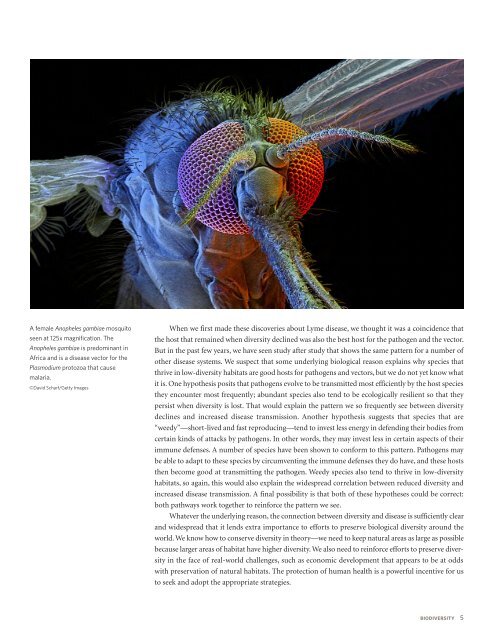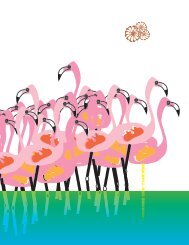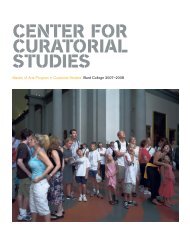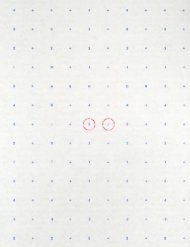Bardian SPRING 2011
Create successful ePaper yourself
Turn your PDF publications into a flip-book with our unique Google optimized e-Paper software.
A female Anopheles gambiae mosquito<br />
seen at 125x magnification. The<br />
Anopheles gambiae is predominant in<br />
Africa and is a disease vector for the<br />
Plasmodium protozoa that cause<br />
malaria.<br />
©David Scharf/Getty Images<br />
When we first made these discoveries about Lyme disease, we thought it was a coincidence that<br />
the host that remained when diversity declined was also the best host for the pathogen and the vector.<br />
But in the past few years, we have seen study after study that shows the same pattern for a number of<br />
other disease systems. We suspect that some underlying biological reason explains why species that<br />
thrive in low-diversity habitats are good hosts for pathogens and vectors, but we do not yet know what<br />
it is. One hypothesis posits that pathogens evolve to be transmitted most efficiently by the host species<br />
they encounter most frequently; abundant species also tend to be ecologically resilient so that they<br />
persist when diversity is lost. That would explain the pattern we so frequently see between diversity<br />
declines and increased disease transmission. Another hypothesis suggests that species that are<br />
“weedy”—short-lived and fast reproducing—tend to invest less energy in defending their bodies from<br />
certain kinds of attacks by pathogens. In other words, they may invest less in certain aspects of their<br />
immune defenses. A number of species have been shown to conform to this pattern. Pathogens may<br />
be able to adapt to these species by circumventing the immune defenses they do have, and these hosts<br />
then become good at transmitting the pathogen. Weedy species also tend to thrive in low-diversity<br />
habitats, so again, this would also explain the widespread correlation between reduced diversity and<br />
increased disease transmission. A final possibility is that both of these hypotheses could be correct:<br />
both pathways work together to reinforce the pattern we see.<br />
Whatever the underlying reason, the connection between diversity and disease is sufficiently clear<br />
and widespread that it lends extra importance to efforts to preserve biological diversity around the<br />
world. We know how to conserve diversity in theory—we need to keep natural areas as large as possible<br />
because larger areas of habitat have higher diversity. We also need to reinforce efforts to preserve diversity<br />
in the face of real-world challenges, such as economic development that appears to be at odds<br />
with preservation of natural habitats. The protection of human health is a powerful incentive for us<br />
to seek and adopt the appropriate strategies.<br />
biodiversity 5
















